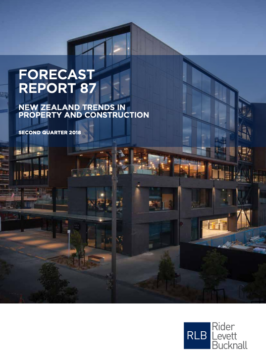Released today, the Rider Levett Bucknall (RLB) Forecast 87 report – New Zealand Trends in Property and Construction – confirms that despite construction remaining strong, capacity constraints limit rate of growth.
Prepared by the New Zealand Institute of Economic Research (Inc.) (NZIER) exclusively for Rider Levett Bucknall (RLB), Forecast 87 highlights that the construction pipeline should be solid for the next few years, as house-building activity lifts to meet increased demand from the surge in population in recent years.
Demand for social buildings overtakes hotels
Grant Watkins, Director of RLB in Wellington said, ‘Demand for social buildings has now overtaken hotel developments as the top driver of growth in nonresidential construction demand over the past year.’
He added, ‘We expect strong tourism activity to underpin further increases in demand for hotels over the coming years. Meanwhile, demand for industrial buildings continues to improve. In contrast, demand for education buildings and healthcare facilities have fallen over the past year, albeit from very high levels, particularly in Canterbury.’
Population growth and tourism continues
Despite net migration continuing to slow, population growth (while moderating) and tourism is expected to underpin many longer-term trends. These include office growth for the higher number of white collar workers, new accommodation buildings for the high number of international visitors, strong domestic tourism and earthquake strengthening activity will also contribute to nonresidential construction demand
Auckland leads non-residential construction growth
Auckland continues to lead growth in non-residential construction demand over the past year. Demand strengthened across a broad range of sectors, with particularly large increases in demand for hotels and social buildings.
Wellington showing soft business confidence
Business confidence has been particularly soft in Wellington in the wake of the new government taking office, and this may further dampen demand for investment in new buildings over the coming year. The recent announcement by Fletcher Building that it will stop bidding for ‘vertical construction’ work also adds uncertainty.
Labour shortages continue
Meanwhile, construction sector firms continue to report acute labour shortages, especially in skilled labour. Migrants have helped to alleviate this, with an increase in technicians and trades’ workers moving to New Zealand on a work visa. RLB expects this to continue, given the amount of construction activity required over the coming years.
Grant concluded, ‘RLB forecasts construction cost inflation to peak at just below 5 percent before moderating to 4 percent by late 2019. Beyond that, we expect annual construction cost inflation to ease to around 3.5 percent in late 2020, as capacity pressures in the construction sector ease.’
RLB New Zealand Trends in Property and Construction Q2 2018
Contact Us
Grant Watkins
T +64 4 384 9198
E grant.watkins@nz.rlb.com
FURTHER INFORMATION:



